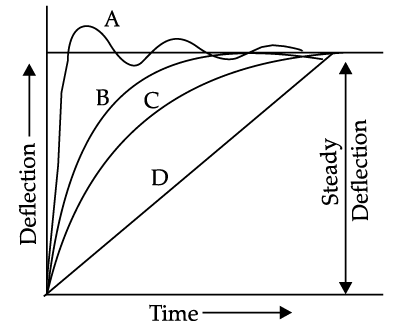Case Based Questions Test: Oscillations - NEET MCQ
10 Questions MCQ Test - Case Based Questions Test: Oscillations
Attempt All sub parts from each question.
Galileo’s Isochronous Pendulum: Galileo observed a lamp swinging from ceiling at Pisa cathedral ceiling. He was the first scientist to observe how long it took any object suspended from a rope or chain (a pendulum) to swing back and forth. There were no wrist watches at that time, so Galileo used his own pulse as a time measurement. Galileo observed that no matter how big the swings were, as in when the lamp was first swung, to how small the swings were as the lamp returned to a standstill, the time it took for each swing to complete was exactly the same. So, he concluded that the oscillations are isochronous. Anyhow, it was proved by advanced experimentation that the isochronism of simple pendulum is correct within 1% under the 30° of amplitude. It is confirmed that the period changes less than 1% until the amplitude is 30°. On the other hand, the period increased by more than 10% when the amplitude became larger than 80°. At the end of his life he devised a scheme for using a pendulum to regulate a mechanical clock. However, the first reliable pendulum clock was only demonstrated by Huygens 15 years after Galileo's death.
Q. Who first observed the time period of a pendulum?
Attempt All sub parts from each question.
Galileo’s Isochronous Pendulum: Galileo observed a lamp swinging from ceiling at Pisa cathedral ceiling. He was the first scientist to observe how long it took any object suspended from a rope or chain (a pendulum) to swing back and forth. There were no wrist watches at that time, so Galileo used his own pulse as a time measurement. Galileo observed that no matter how big the swings were, as in when the lamp was first swung, to how small the swings were as the lamp returned to a standstill, the time it took for each swing to complete was exactly the same. So, he concluded that the oscillations are isochronous. Anyhow, it was proved by advanced experimentation that the isochronism of simple pendulum is correct within 1% under the 30° of amplitude. It is confirmed that the period changes less than 1% until the amplitude is 30°. On the other hand, the period increased by more than 10% when the amplitude became larger than 80°. At the end of his life he devised a scheme for using a pendulum to regulate a mechanical clock. However, the first reliable pendulum clock was only demonstrated by Huygens 15 years after Galileo's death.
Q. Galileo observed that the time period of the pendulum
Attempt All sub parts from each question.
Galileo’s Isochronous Pendulum: Galileo observed a lamp swinging from ceiling at Pisa cathedral ceiling. He was the first scientist to observe how long it took any object suspended from a rope or chain (a pendulum) to swing back and forth. There were no wrist watches at that time, so Galileo used his own pulse as a time measurement. Galileo observed that no matter how big the swings were, as in when the lamp was first swung, to how small the swings were as the lamp returned to a standstill, the time it took for each swing to complete was exactly the same. So, he concluded that the oscillations are isochronous. Anyhow, it was proved by advanced experimentation that the isochronism of simple pendulum is correct within 1% under the 30° of amplitude. It is confirmed that the period changes less than 1% until the amplitude is 30°. On the other hand, the period increased by more than 10% when the amplitude became larger than 80°. At the end of his life he devised a scheme for using a pendulum to regulate a mechanical clock. However, the first reliable pendulum clock was only demonstrated by Huygens 15 years after Galileo's death.
Q. Isochronism of simple pendulum is within acceptable limit as long as the amplitude is under
Attempt All sub parts from each question.
Galileo’s Isochronous Pendulum: Galileo observed a lamp swinging from ceiling at Pisa cathedral ceiling. He was the first scientist to observe how long it took any object suspended from a rope or chain (a pendulum) to swing back and forth. There were no wrist watches at that time, so Galileo used his own pulse as a time measurement. Galileo observed that no matter how big the swings were, as in when the lamp was first swung, to how small the swings were as the lamp returned to a standstill, the time it took for each swing to complete was exactly the same. So, he concluded that the oscillations are isochronous. Anyhow, it was proved by advanced experimentation that the isochronism of simple pendulum is correct within 1% under the 30° of amplitude. It is confirmed that the period changes less than 1% until the amplitude is 30°. On the other hand, the period increased by more than 10% when the amplitude became larger than 80°. At the end of his life he devised a scheme for using a pendulum to regulate a mechanical clock. However, the first reliable pendulum clock was only demonstrated by Huygens 15 years after Galileo's death.
Q. First reliable pendulum clock was only demonstrated by
Attempt All sub parts from each question.
Galileo’s Isochronous Pendulum: Galileo observed a lamp swinging from ceiling at Pisa cathedral ceiling. He was the first scientist to observe how long it took any object suspended from a rope or chain (a pendulum) to swing back and forth. There were no wrist watches at that time, so Galileo used his own pulse as a time measurement. Galileo observed that no matter how big the swings were, as in when the lamp was first swung, to how small the swings were as the lamp returned to a standstill, the time it took for each swing to complete was exactly the same. So, he concluded that the oscillations are isochronous. Anyhow, it was proved by advanced experimentation that the isochronism of simple pendulum is correct within 1% under the 30° of amplitude. It is confirmed that the period changes less than 1% until the amplitude is 30°. On the other hand, the period increased by more than 10% when the amplitude became larger than 80°. At the end of his life he devised a scheme for using a pendulum to regulate a mechanical clock. However, the first reliable pendulum clock was only demonstrated by Huygens 15 years after Galileo's death.
Q. How the time period of a pendulum was measured in the beginning of 16th century?
Attempt All sub parts from each question.
Damping: When an analog instrument is used to measure a physical parameter, a deflecting torque is applied to the moving system which is deflected from its initial position and should move steadily to the deflected position. But due to inertia, the moving system keeps on oscillating about equilibrium. To remove the oscillation of the moving system a damping torque is required. The damping torque should be of such that the pointer quickly comes to its final steady position, without overshooting. If the instrument is underdamped, the moving system will oscillate about the final steady position with a decreasing amplitude and will take some time before it comes to rest. When the moving system moves rapidly but smoothly to its final steady position, the instrument is said to be critically damped or deadbeat. If the damping torque is more than what is required for critical damping, the instrument is said to be overdamped. In an overdamped instrument, the moving system moves slowly to its final steady position in a lethargic fashion.
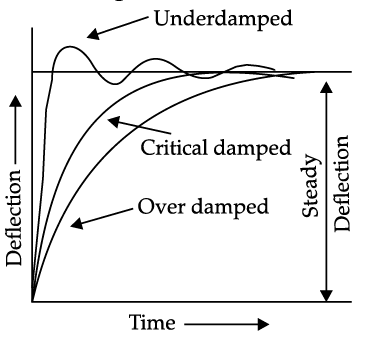
Methods of producing damping torque:
(i) Air friction damping
(ii) Fluid friction damping
(iii) Eddy current damping
Air Friction Damping: A light piston is attached to the moving system. This piston moves in an air chamber closed at one end. When there is an oscillation, the piston moves in and out of the chamber. When the piston moves into the chamber, the air inside is compressed and an air pressure is built up which opposes the motion of the piston and thus the moving system faces a damping torque which ultimately reduces the oscillation. Fluid Friction Damping: In this type of damping oil is used in place of air. Viscosity of the oil being greater, the damping torque is also more. A disc is attached to the moving system which is completely dipped into the oil. When the moving system oscillates, the disc moves in oil and a frictional drag is produced. This frictional drag opposes the oscillation. Eddy Current Damping: The moving system is connected to an aluminium disc which rotates in a magnetic field. Rotation in magnetic field induces an emf in it and if the path is closed, a current (known as eddy current) flows. This current interacts with the magnetic field to produce an electromagnetic torque which opposes the motion. This torque is proportional to the oscillation of the moving system. This electromagnetic torque ultimately reduces the oscillation. Air friction damping provides a very simple and cheap method of damping. The disadvantages of fluid friction damping are that it can be used only for instruments which are in vertical position. Eddy current damping is the most efficient form of damping.
Q. Damping is required to be provided to the moving part of measuring instrument
Attempt All sub parts from each question.
Damping: When an analog instrument is used to measure a physical parameter, a deflecting torque is applied to the moving system which is deflected from its initial position and should move steadily to the deflected position. But due to inertia, the moving system keeps on oscillating about equilibrium. To remove the oscillation of the moving system a damping torque is required. The damping torque should be of such that the pointer quickly comes to its final steady position, without overshooting. If the instrument is underdamped, the moving system will oscillate about the final steady position with a decreasing amplitude and will take some time before it comes to rest. When the moving system moves rapidly but smoothly to its final steady position, the instrument is said to be critically damped or deadbeat. If the damping torque is more than what is required for critical damping, the instrument is said to be overdamped. In an overdamped instrument, the moving system moves slowly to its final steady position in a lethargic fashion.
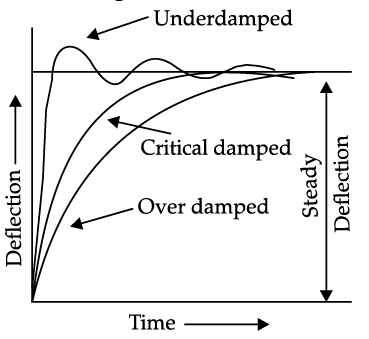
Methods of producing damping torque:
(i) Air friction damping
(ii) Fluid friction damping
(iii) Eddy current damping
Air Friction Damping: A light piston is attached to the moving system. This piston moves in an air chamber closed at one end. When there is an oscillation, the piston moves in and out of the chamber. When the piston moves into the chamber, the air inside is compressed and an air pressure is built up which opposes the motion of the piston and thus the moving system faces a damping torque which ultimately reduces the oscillation. Fluid Friction Damping: In this type of damping oil is used in place of air. Viscosity of the oil being greater, the damping torque is also more. A disc is attached to the moving system which is completely dipped into the oil. When the moving system oscillates, the disc moves in oil and a frictional drag is produced. This frictional drag opposes the oscillation. Eddy Current Damping: The moving system is connected to an aluminium disc which rotates in a magnetic field. Rotation in magnetic field induces an emf in it and if the path is closed, a current (known as eddy current) flows. This current interacts with the magnetic field to produce an electromagnetic torque which opposes the motion. This torque is proportional to the oscillation of the moving system. This electromagnetic torque ultimately reduces the oscillation. Air friction damping provides a very simple and cheap method of damping. The disadvantages of fluid friction damping are that it can be used only for instruments which are in vertical position. Eddy current damping is the most efficient form of damping.
Q. The most efficient form of damping is
Attempt All sub parts from each question.
Damping: When an analog instrument is used to measure a physical parameter, a deflecting torque is applied to the moving system which is deflected from its initial position and should move steadily to the deflected position. But due to inertia, the moving system keeps on oscillating about equilibrium. To remove the oscillation of the moving system a damping torque is required. The damping torque should be of such that the pointer quickly comes to its final steady position, without overshooting. If the instrument is underdamped, the moving system will oscillate about the final steady position with a decreasing amplitude and will take some time before it comes to rest. When the moving system moves rapidly but smoothly to its final steady position, the instrument is said to be critically damped or deadbeat. If the damping torque is more than what is required for critical damping, the instrument is said to be overdamped. In an overdamped instrument, the moving system moves slowly to its final steady position in a lethargic fashion.
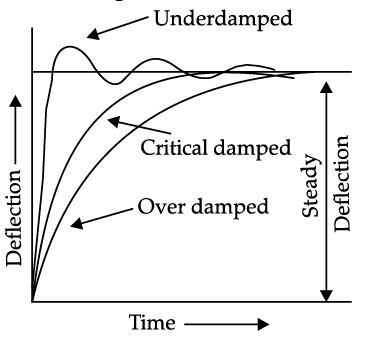
Methods of producing damping torque:
(i) Air friction damping
(ii) Fluid friction damping
(iii) Eddy current damping
Air Friction Damping: A light piston is attached to the moving system. This piston moves in an air chamber closed at one end. When there is an oscillation, the piston moves in and out of the chamber. When the piston moves into the chamber, the air inside is compressed and an air pressure is built up which opposes the motion of the piston and thus the moving system faces a damping torque which ultimately reduces the oscillation. Fluid Friction Damping: In this type of damping oil is used in place of air. Viscosity of the oil being greater, the damping torque is also more. A disc is attached to the moving system which is completely dipped into the oil. When the moving system oscillates, the disc moves in oil and a frictional drag is produced. This frictional drag opposes the oscillation. Eddy Current Damping: The moving system is connected to an aluminium disc which rotates in a magnetic field. Rotation in magnetic field induces an emf in it and if the path is closed, a current (known as eddy current) flows. This current interacts with the magnetic field to produce an electromagnetic torque which opposes the motion. This torque is proportional to the oscillation of the moving system. This electromagnetic torque ultimately reduces the oscillation. Air friction damping provides a very simple and cheap method of damping. The disadvantages of fluid friction damping are that it can be used only for instruments which are in vertical position. Eddy current damping is the most efficient form of damping.
Q. When the moving system of a measuring instrument moves rapidly but smoothly to its final steady position, the instrument is said to be
Attempt All sub parts from each question.
Damping: When an analog instrument is used to measure a physical parameter, a deflecting torque is applied to the moving system which is deflected from its initial position and should move steadily to the deflected position. But due to inertia, the moving system keeps on oscillating about equilibrium. To remove the oscillation of the moving system a damping torque is required. The damping torque should be of such that the pointer quickly comes to its final steady position, without overshooting. If the instrument is underdamped, the moving system will oscillate about the final steady position with a decreasing amplitude and will take some time before it comes to rest. When the moving system moves rapidly but smoothly to its final steady position, the instrument is said to be critically damped or deadbeat. If the damping torque is more than what is required for critical damping, the instrument is said to be overdamped. In an overdamped instrument, the moving system moves slowly to its final steady position in a lethargic fashion.
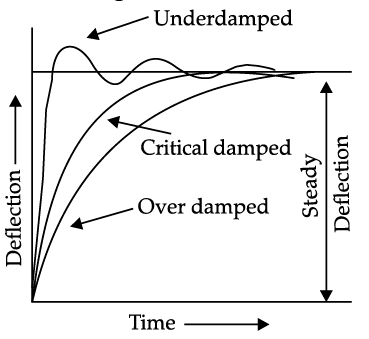
Methods of producing damping torque:
(i) Air friction damping
(ii) Fluid friction damping
(iii) Eddy current damping
Air Friction Damping: A light piston is attached to the moving system. This piston moves in an air chamber closed at one end. When there is an oscillation, the piston moves in and out of the chamber. When the piston moves into the chamber, the air inside is compressed and an air pressure is built up which opposes the motion of the piston and thus the moving system faces a damping torque which ultimately reduces the oscillation. Fluid Friction Damping: In this type of damping oil is used in place of air. Viscosity of the oil being greater, the damping torque is also more. A disc is attached to the moving system which is completely dipped into the oil. When the moving system oscillates, the disc moves in oil and a frictional drag is produced. This frictional drag opposes the oscillation. Eddy Current Damping: The moving system is connected to an aluminium disc which rotates in a magnetic field. Rotation in magnetic field induces an emf in it and if the path is closed, a current (known as eddy current) flows. This current interacts with the magnetic field to produce an electromagnetic torque which opposes the motion. This torque is proportional to the oscillation of the moving system. This electromagnetic torque ultimately reduces the oscillation. Air friction damping provides a very simple and cheap method of damping. The disadvantages of fluid friction damping are that it can be used only for instruments which are in vertical position. Eddy current damping is the most efficient form of damping.
Q. In Fluid Friction Damping the amount of damping torque
Attempt All sub parts from each question.
Damping: When an analog instrument is used to measure a physical parameter, a deflecting torque is applied to the moving system which is deflected from its initial position and should move steadily to the deflected position. But due to inertia, the moving system keeps on oscillating about equilibrium. To remove the oscillation of the moving system a damping torque is required. The damping torque should be of such that the pointer quickly comes to its final steady position, without overshooting. If the instrument is underdamped, the moving system will oscillate about the final steady position with a decreasing amplitude and will take some time before it comes to rest. When the moving system moves rapidly but smoothly to its final steady position, the instrument is said to be critically damped or deadbeat. If the damping torque is more than what is required for critical damping, the instrument is said to be overdamped. In an overdamped instrument, the moving system moves slowly to its final steady position in a lethargic fashion.

Methods of producing damping torque:
(i) Air friction damping
(ii) Fluid friction damping
(iii) Eddy current damping
Air Friction Damping: A light piston is attached to the moving system. This piston moves in an air chamber closed at one end. When there is an oscillation, the piston moves in and out of the chamber. When the piston moves into the chamber, the air inside is compressed and an air pressure is built up which opposes the motion of the piston and thus the moving system faces a damping torque which ultimately reduces the oscillation. Fluid Friction Damping: In this type of damping oil is used in place of air. Viscosity of the oil being greater, the damping torque is also more. A disc is attached to the moving system which is completely dipped into the oil. When the moving system oscillates, the disc moves in oil and a frictional drag is produced. This frictional drag opposes the oscillation. Eddy Current Damping: The moving system is connected to an aluminium disc which rotates in a magnetic field. Rotation in magnetic field induces an emf in it and if the path is closed, a current (known as eddy current) flows. This current interacts with the magnetic field to produce an electromagnetic torque which opposes the motion. This torque is proportional to the oscillation of the moving system. This electromagnetic torque ultimately reduces the oscillation. Air friction damping provides a very simple and cheap method of damping. The disadvantages of fluid friction damping are that it can be used only for instruments which are in vertical position. Eddy current damping is the most efficient form of damping.
Q. In the following deflection-time graphs which one is ideal for a sensitive and steady measuring instrument?
